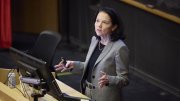Despite the race to deploy vaccines, two new variants of SARS-CoV-2 that are more transmissible than the prevailing strain are poised to amplify spread of the pandemic worldwide, complicating control efforts, and changing the prospects for a return to normalcy said experts from the Harvard T.H. Chan School of Public Health (HSPH) this week. Among the alarming implications are that a much higher proportion of the population must be vaccinated (or survive infection) to achieve “herd immunity” from the virus, and that the strategy for vaccination must change to reach more people more quickly to save many more threatened lives and prevent the health-care system from collapsing.
A More Contagious Virus
The first of these variants, initially detected in the United Kingdom and now present in more than three dozen countries, is estimated to be 50 percent more transmissible than the standard form of SARS-CoV-2. This increase in infectiousness will cause the number of new cases to grow faster, like compound interest in a bank account: once the variant becomes common in the United States, said professor of epidemiology Marc Lipsitch during a January 5 call with reporters, that would lead to twice the number of expected cases in less than two weeks, and “four to five times as many in a month” if “we don’t change our control measures….” He added that “the two things that will push in the other direction are increased vaccination and—if we can delay it enough—the warmer weather and reduced indoor contacts” of late spring. “But I think by then [the variant] is likely to be quite common in the United States.”
This new form of the virus first raised concerns in November, when epidemiologists identified a cluster of 100 closely related cases in the U.K., explained associate professor of epidemiology William Hanage during an earlier, December 22, call with reporters. The variant, called B.1.1.7, displays 23 mutations “in regions that are thought to be important in terms of interacting with the human host and possibly the immune system.”
The number of changes alone make B.1.1.7 unusual. Normally, scientists estimate how many mutations they expect to see in the viral genome based on the amount of time that has passed since the outbreak began. “This is what’s called a molecular clock,” explained Hanage. “You assume that the virus accumulates mutations at a specific rate. However,” he said, “this particular variant has about 20 more than you would expect, given the time when it was first detected in the middle of September.”
The changes have made this form of the virus much more contagious: “By December,” Hanage said, “it was responsible for around 60 to 70 percent of new cases in the southeast of England. That’s a very rapid increase from the point when it was first detected.” Eight of the mutations and two deletions are in the spike protein, which mediates attachment to the host receptor in human cells (called ACE2).
Fortunately, none of the changes in the U.K. variant have made it less susceptible to the antibodies generated by vaccines, either in people or animals, reported Jacobson research professor of public health Barry Bloom, former dean of HSPH. “So that is very comforting,” he said.
But the enhanced transmissibility of the U.K. variant does have important implications for the level of vaccination that will be required, and the optimal order of priority for vaccine distribution.
Herd immunity. First, it raises the threshold for “herd immunity” (the term that describes the condition when a sufficiently large percentage of a population becomes immune to a disease either through infection or vaccination, so that transmission no longer occurs readily, thus protecting even those who are not immune). Achieving herd immunity is a prerequisite for a return to life without masks and social distancing. In a world without public health interventions, if the standard strain of SARS-CoV-2 causes each infected person to infect three other people in turn, the threshold for reaching herd immunity would be 66 percent of the population. If the U.K. variant is 50 percent more transmissible, as the evidence suggests, that means each case would on average lead to 4.5 additional people infected. In that scenario, 78 percent of the population would need to be immune. And since vaccines are never 100 percent protective, that implies vaccine coverage for as much as 90 percent of the population—the new, upper end of the range being cited by Anthony Fauci, S.D. ’09, who is director of the National Institute of Allergy and Infectious Diseases—probably due to his concern about the new variant, Bloom pointed out.
Vaccine distribution. A second important implication of enhanced transmissibility concerns vaccine distribution. Lipsitch, who directs Harvard’s Center for Communicable Disease Dynamics, said that mathematical models of how pandemics unfold show that when a pathogen is less transmissible, vaccinating populations who are most likely to spread the disease is an important way of slowing the rate of infection. But the more transmissible a pathogen, the stronger the case for vaccinating those populations most likely to develop severe disease or to die—they get the “direct benefit” of protection that “doesn’t depend on how contagious” the virus is. That is why prioritizing the elderly and those with comorbidities, Lipsitch said, “becomes more compelling with a more transmissible strain.” Based on such calculations, Lipsitch believes that people over the age of 65—not just those over 75—should be among the first to be vaccinated. The problem, he acknowledged, is that the 65-plus cohort is a large group, and adding them to the first wave would delay vaccination of essential workers. “My simple view,” he said, “is that public-health policy, as a first pass, should try to minimize the number of lives lost.”
How Should Governments Respond?
Lipsitch said that controlling the spread of the new variant, delaying its spread for as long as possible while vaccines roll out to the population, should be the focus of current public-health efforts. Contact tracing should prioritize detection of the variant, in order to “shut down” those chains of transmission. While the United States has a “very primitive system of surveillance” for detecting the variant, meaning “it is probably more widespread than we think,” standard screening tools, such as the widely used Thermo Fisher PCR test, can at least rule out whether any particular infection is caused by the new form of the virus. In cases where the presence of the variant can’t be ruled out, genomic sequencing would then be necessary. Lipsitch added that “the U.K. has been sequencing thousands of samples a month in a smaller population than ours. If you were really trying to do it on a shoestring, I think if you did 1,000 isolates every two weeks or so, from a representative sample around the country, perhaps oversampling in places where people are coming in from outside the country, you would have a pretty sensitive early detection system. And you would also have a set of data telling you how the virus is evolving within the United States. That would be a minimal approach.” Ultimately, he said. “There’s no reason, given the how cheap the technology is,” using robotics and other technologies, “why we couldn’t do much more than that” and develop a system, ready to prevent the next pandemic, for detecting a whole range of viruses.
Lipsitch and Bloom both emphasized that while the vaccines authorized for emergency use so far offer robust protection against severe disease, their ability to reduce transmission is less clear. In fact, Lipsitch wrote in December that “it seems very possible that [vaccines] will provide only partial protection against infection and transmission.” For that reason, being vaccinated should not as a matter of public policy be sufficient to issue “health passports” guaranteeing that the holder is virus-free. Testing, Lipsitch said, remains a better way to determine if someone is infectious—and therefore safe to travel on an airplane, for example.
The South African mutation. Bloom shared Lipsitch’s concerns about the U.K. variant, but said that he is actually more concerned about the South African form of the virus. That variant is also more transmissible, but his principal worry comes from preliminary studies that suggest it may be able to resist neutralizing antibodies of the sort induced by infection. That would be a serious problem, and so bears watching as the evidence accumulates.
Putting that additional concern aside for a moment, Lipsitch acknowledges that the enhanced transmissibility of these new variants may mean that achievable levels of vaccine coverage “might not be enough, on their own, to prevent sustained transmission, though they might be close.” Still, he hoped that by late spring or early summer, “the level of vaccine coverage in the rich countries will get to the point where the healthcare system is no longer crushed.” As he wrote in December,
Importantly, sustained herd immunity is not the only value of a vaccine or the only way it could help us return to a more normal life. If high coverage can be achieved in those most at risk of severe outcomes, we could achieve a state where virus continues to circulate (at a level reduced by partial herd immunity) but the toll on the health system and the mortality toll is dramatically reduced because fewer highly vulnerable people are infected, and even fewer of those experience symptoms, thanks to direct protection by the vaccine. In my personal opinion, this is the most likely path to a more normal life in many countries.









